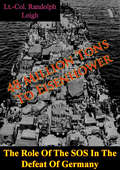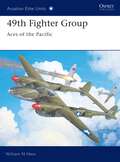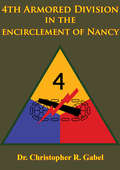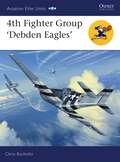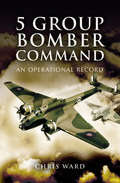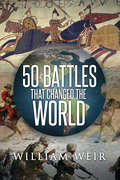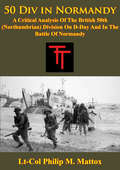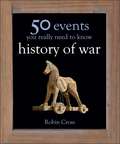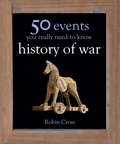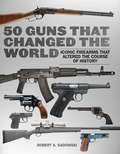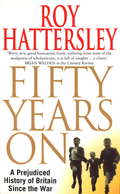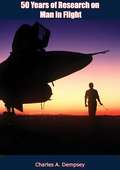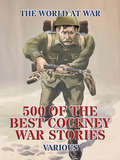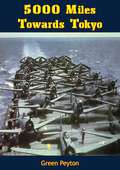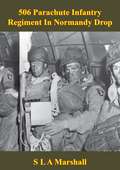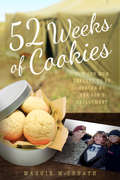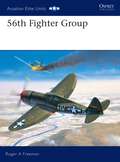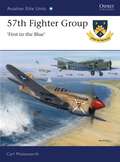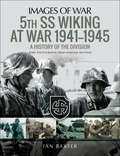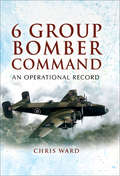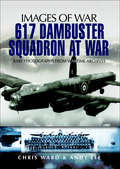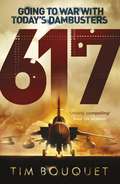- Table View
- List View
48 Million Tons To Eisenhower: The Role Of The SOS In The Defeat Of Germany [Illustrated Edition]
by Lt.-Col. Randolph LeighThis book is not intended as a definitive history of this phase of the American effort in Europe, but to record the highlights of that great project.Obviously no one person could gather and evaluate all the material for a book on the Services of Supply of the United States Army in the European Theater of Operations. Actually more than one hundred persons, ranging from a private first class to the Supreme Commander of the Allied Expeditionary Forces, contributed variously. Ten general officers, for instance, read proof and criticized chapters dealing with their particular branches.The material as a whole, however, was gathered through the Historical Section of ETO and by the historians of the staff sections. The idea of the book originated with Colonel William A. Ganoe, the original Theater Historian.
49th Fighter Group
by Chris Davey William HessThe 49th FG was sent to Australia in early 1942 to help stem the tide of Japanese conquest in Java. Too late to save the island, the group went into action in the defence of Darwin, Australia, where the Forty-Niners' handful of P-40E Warhawks were thrown into combat alongside survivors from the defeated forces that had fled from the Philippines and Java. This book assesses the outstanding performance of the 49th FG, pitted against superior Japanese forces. By VJ-Day the group had scored 668 aerial victories and won three Distinguished Unit Citations and ten campaign stars for its outstanding efforts.
4th Armored Division In The Encirclement Of Nancy [Illustrated Edition]
by Dr Christopher R. Gabel[Illustrated with 3 figures and 8 maps]In 1944, the 4th Armored Division played a central role in one of the more remarkable campaigns in American military history - Third Army's pursuit across France, which was capped off by the encirclement and capture of Nancy. In the course of this campaign, the 4th Armored Division practiced a mode of warfare that has since become known to the Army as AirLand Battle. In as much as the encirclement of Nancy is one of the few historical examples that shows American mechanized forces waging war in accordance with the tenets of AirLand Battle, anyone seeking a deeper appreciation of today's doctrine would do well to study this campaign carefully. The 4th Armored Division in the Encirclement of Nancy originated at the U.S. Army Command and General Staff College as an introductory class for a course on modern division level operations. It is a companion piece to The Lorraine Campaign: An Overview, September-December 1944, published in February 1985.
4th Fighter Group - Debden Eagles
by Chris Davey Chris BucholtzFormed around a nucleus of pilots already seasoned by their experience as volunteers in the RAF's Eagle Squadrons, the 4th Fighter Group was established in England in October 1942. Initially flying Spitfires, the Debden Eagles went on to fly the P-47 and P-51, becoming in July 1943, the first Eighth Air Force fighter group to penetrate German air space. The group's record of 583 air and 469 ground victories was unmatched in the Eighth Air Force, and the group produced a cast of characters that included legendary aces Don Blakeslee, Pierce McKennon, 'Kid' Hofer, Duane Beeson, Steve Pisanos and Howard Hively. While primarily a bomber escort group, the 4th also played roles in supporting the D-Day landings, Operation Market Garden, the Battle of the Bulge and the crossing of the Rhine. The group's achievements came at a price, however, for 248 aircraft were lost in combat, with 125 pilots killed in action and 105 being taken prisoner - a 42 percent casualty rate. Packed with first hand accounts, detailed aircraft profiles and full combat histories, this book is an intriguing insight into the best-known American fighter unit in World War 2.
5 Group Bomber Command: An Operational Record
by Chris WardDuring the immediate period before World War Two, the RAF modified its command structure to rationalize for rapid expansion. Bomber Command was divided into six operational groups, each flying the same type of aircraft. In 1939 5 Group was flying the Handley Page Hampden, a fast, modern aircraft that carried a large payload. However, during the early daylight raids into enemy occupied Europe it suffered great losses due to its defensive armament leaving too many blind spots. The Group now turned to night bombing and mine-laying operations. During November 1940, the first Avro Manchesters entered service but were to prove dangerously unreliable. It was not until the Avro Lancaster began arriving in strength that the Group began its proud history of successful and often highly dangerous raids into the Reich, the most famous of which was No 617 Squadrons attack on the Mohne, Eder and Sorpe dams.Between 1939 and 1945 the Group flew 70,351 sorties with the loss of 1,888 aircraft. This book contains a lengthy narrative of the groups operations and contains individual squadron statistics, their commanding officers, stations and aircraft losses. It provides a detailed reference for one of the RAFs most important and successful operational groups.
50 Battles That Changed the World
by William WeirAn informative look at the military conflicts that most altered the course of history and civilization, from ancient times to the modern world.Rather than celebrating warfare, 50 Battles That Changed the World looks at the clashes the author believes have had the most profound impact on world history. Ranked in order of their relevance to the modern world, these struggles range from the ancient past to the present day and span the globe many times over.Some of the battles in this book are familiar to us all—Bunker Hill, which prevented the American Revolution from being stillborn, and Marathon, which kept the world’s first democracy alive. Others may be less familiar—the naval battle at Diu (on the Indian Coast), which led to the ascendancy of Western Civilization and the discovery of America, and Yarmuk, which made possible the spread of Islam from Morocco to the Philippines.With remarkable accounts of both famous and lesser-known clashes, 50 Battles That Changed the World provides impressive insight into the battles that shaped civilization as we know it.
50 Div In Normandy: A Critical Analysis Of The British 50th (Northumbrian) Division On D-Day And In The Battle Of Normandy
by L-Cmdr Ethan R. WilliamsIn late 1943, the British army ordered the veteran 7th Armored, 51st (Highland), and 50th (Northumbrian) Divisions to return to the Great Britain to provide combat experienced troops for the invasion of northwest Europe. On D-Day, the 50th Division achieved nearly all of its objectives. By mid-June, however, the 50th held positions only a few miles beyond its final D-Day positions. The apparent failures of the veteran divisions in later operations led many senior leaders to believe that these divisions had become a liability. This thesis will evaluate the performance of the 50th Division in Normandy by first examining the period before the invasion to determine the 50th's readiness for war, British army doctrine, and weapons. The 50th's prior combat experiences and pre-invasion training will be analyzed to determine the effect that prior combat had on the division. Finally, this thesis will evaluate the performance of the 50th Division in specific combat engagements in Normandy.
50 Events You Really Need to Know: History of War
by Robin CrossHuman history--from the empires of the ancient world to the superpowers of the 21st century--has been inextricably shaped by conflict and the weapons that have been used to wage it. The technologies that have produced advanced civilizations have also been harnessed to the grim business of warfare. The trains that carried working people to their first seaside holidays in the 19th century also took millions of young men to war in 1914. Nearly a century later, the computer revolution, which by 2000 had come to dominate almost every aspect of life in advanced societies, had also introduced us to a new fifth dimension of warfare, in which governments jostle brutally in cyberspace.This short history, stretching from the chariot to the Stuxnet virus which disabled Iran's nuclear enrichment programme in 2007, charts some of the most significant weapons, fortifications and tactics that have been developed in the last 2,500 years.Since 1945, the pace of change has been relentless. In the present day, the main battle tank is facing obsolescence as the master of the battlefield, and the introduction of the Unmanned Combat Aerial Vehicle (UCAV) threatens the livelihoods of many of the highly trained establishments of the world's leading air forces. In contrast, the many asymmetric conflicts raging around the globe in countries of the Third World attest to the durability of one of the 20th century's most remarkable weapons, the Kalashnikov assault rifle, developed in the later 1940s and still in service worldwide. This is a scintillating introduction to the world's most enduring phenomenon.
50 Events You Really Need to Know: History of War
by Robin CrossHuman history - from the empires of the ancient world to the superpowers of the 21st century - has been inextricably shaped by conflict and the weapons that have been used to wage it. The technologies that have produced advanced civilizations have also been harnessed to the grim business of warfare. This short history, stretching from the chariot to the Stuxnet virus which disabled Iran's nuclear enrichment programme in 2007, charts some of the most significant weapons, fortifications and tactics that have been developed in the last 2,500 years. It is a scintillating introduction to the world's most enduring phenomenon.The 50 events include: The Egyptian New Kingdom; Heavy infantry tactics; Grand strategy of Alexander the Great; Naval warfare; Legion versus phalanx; The army on the march; Roman siegecraft; Kingship and command; Cavalry and castles; The age of chivalry; The changing battlefield; Siege trains and siegecraft; The age of Vauban; The age of Frederick the Great; The Seven Years' War; Colonial conflict; Napoleon, tactics and grand strategy; Nelson and naval tactics; The rise of the Dreadnought; Steam and steel; Firepower; Mobilization; Trench warfare; Air warfare; The Manhattan Project and Cyberwar.
50 Events You Really Need to Know: History of War (50 Ideas You Really Need to Know series)
by Robin CrossHuman history - from the empires of the ancient world to the superpowers of the 21st century - has been inextricably shaped by conflict and the weapons that have been used to wage it. The technologies that have produced advanced civilizations have also been harnessed to the grim business of warfare. This short history, stretching from the chariot to the Stuxnet virus which disabled Iran's nuclear enrichment programme in 2007, charts some of the most significant weapons, fortifications and tactics that have been developed in the last 2,500 years. It is a scintillating introduction to the world's most enduring phenomenon.The 50 events include: The Egyptian New Kingdom; Heavy infantry tactics; Grand strategy of Alexander the Great; Naval warfare; Legion versus phalanx; The army on the march; Roman siegecraft; Kingship and command; Cavalry and castles; The age of chivalry; The changing battlefield; Siege trains and siegecraft; The age of Vauban; The age of Frederick the Great; The Seven Years' War; Colonial conflict; Napoleon, tactics and grand strategy; Nelson and naval tactics; The rise of the Dreadnought; Steam and steel; Firepower; Mobilization; Trench warfare; Air warfare; The Manhattan Project and Cyberwar.
50 Guns That Changed the World: Iconic Firearms That Altered the Course of History
by Robert A. SadowskiDiscover how fifty great firearms influenced and helped shape our world. World history has always been interwoven with developments in firearms technology and so is peppered with legendary guns. Since the invention of gunpowder, nations have raced to create more useful and powerful firearms with which to protect, conquer, and hunt. 50 Guns That Changed the World explores the most significant firearms from the past two hundred years, from deadly weapons of war to quaint plinking guns. Included are: Winchester Model 1873 Colt 1911 Mauser Model 98 M1 Garand Ruger 10/22 AK-47 AR-15 Benelli M2 Glock G17 Barrett 82A1 Discover the history, design details, operation, variants, and users of each firearm, illustrated with archival photography from the manufacturers and of the guns in action. Firearms enthusiasts, history buffs, hunters, and shooters will all find something to marvel at in this gorgeous full-color book.
50 Years On: A Prejudiced History of Britain Since the War
by Roy HattersleyIn FIFTY YEARS ON, Roy Hattersley explores and explains the events which have shaped modern Britain. Combining acute analysis of domestic politics with a brilliant eye for the bigger picture, his 'prejudiced history' takes the reader from the high hopes of 1945 to the cynicism of end-of century Britain. Roy Hattersley focuses his attention on two particular features of post-war Britain: the perpetuation of an education system which fails to meet the needs of the whole country, and our stubborn refusal to accept that the United Kingdom is a medium-sized European nation which can only increase its power and prosperity by real integration within the European union. FIFTY YEARS ON is essential reading for anyone seeking to understand the forces that have shaped us.
50 Years On: A Prejudiced History of Britain Since the War
by Roy HattersleyIn FIFTY YEARS ON, Roy Hattersley explores and explains the events which have shaped modern Britain. Combining acute analysis of domestic politics with a brilliant eye for the bigger picture, his 'prejudiced history' takes the reader from the high hopes of 1945 to the cynicism of end-of century Britain. Roy Hattersley focuses his attention on two particular features of post-war Britain: the perpetuation of an education system which fails to meet the needs of the whole country, and our stubborn refusal to accept that the United Kingdom is a medium-sized European nation which can only increase its power and prosperity by real integration within the European union. FIFTY YEARS ON is essential reading for anyone seeking to understand the forces that have shaped us.
50 Years of Research on Man in Flight
by Charles A. DempseyThis 50th Anniversary Celebration is a gala review of the last half century of research in aviation medicine. This research has fundamentally shaped the evolution of aircraft design from the wood and wire biplanes to the Space Shuttle. Many renowned scientists have worked in this creative multidisciplinary environment, to evolve pioneering knowledge and established World records that have stood the test of time. Their numbers are legend. Their efforts are unsurpassed anywhere in the world. The published literature from 1935 to 1985 has set the standard for air vehicle design in this country and abroad. Wherever man interfaces with the air vehicle, the mark of aeromedical research is clearly evident in both the hardware design and its functional operation. It is the integration of engineering and medicine which made these achievements possible. The next half century will make even bolder strokes in manned flight.
500 of the Best Cockney War Stories (The World At War)
by Various VariousExcerpt: "On the morning of September 11, 1879, I lay shivering with fever and ague at Alikhel in Afghanistan. So sick did I seem that it was decided I should be carried a day's march back to G.H.Q. on the Peiwar Kotal to see if the air of that high mountain pass would help me to pull myself round. Polly Forbes, a boy subaltern not very long from Eton, was sent off to play the part of nurse. We reached the Peiwar Kotal without any adventure, and were allotted a tent in the G.H.Q. camp pitched where the road between the Kurram Valley and Kabul ran over the high Kotal or pass. Next morning, although still rather weak in the knees, I felt game for a ride to the battlefield. So we rode along the high ridge through the forest of giant deodars looking for mementoes of the battle. The fact was that we were, although we knew it not, in a very dangerous No Man's Land. We had reached a point about two miles from camp when we were startled by half a dozen shots fired in quick succession and still more startled to see some British soldiers rushing down towards us from the top of a steep-sided knoll which crowned the ridge to our immediate front. Close past us rushed those fugitives and on, down the hillside, where at last, some hundred yards below us, they pulled up in answer to our[10] shouts. But no amount of shouts or orders would bring them up to us, so we had to get off our ponies and go down to them. There were seven of them—a Corporal and three men belonging to one of the new short service battalions and three signallers—very shaky the whole lot. Only one was armed with his rifle; he had been on sentry-go at the moment the signalling picquet had been rushed—so they said—by a large body of Afghans. What was to be done? I realised that I was the senior. Turning to the Corporal I asked him if he could ride. "Yes, sir," he replied rather eagerly. "Well, then," I commanded, "you get on to that little white mare up there and ride like hell to G.H.Q. for help. You others go up with him and await orders." Off they went, scrambling up the hill, Forbes and I following rather slowly because of my weakness. When we got up to the path, ponies, syces, all had disappeared except that one soldier who had stuck to his rifle."
5000 Miles Towards Tokyo
by Green PeytonHow the United States won the Naval Struggle in the Pacific…HERE AT LAST IS THE ACCOUNT OF the brilliant but hitherto undescribed strategy which carried American amphibious forces from the American West coast to the gates of Tokyo. Written by Green Peyton, novelist, journalist, and most recently a naval officer in the Pacific, it tells why Japan was already on her knees when the first atomic bomb landed and Russia marched on Manchuria.Within one year, the United States changed from a nation fighting a delaying or defensive war in the Pacific to an aggressive, offensive force. The story of this amphibious war in the Pacific is told through Air Group 60 on the converted tanker Suwannee, whose members took part in every important invasion from Tarawa in November 1943, which was the Navy’s first major offensive against Japan, to Leyte in October 1944, which was the climax of the naval war in the East. Other actions included the invasion of Kwajalein, Eniwetok, Hollandia, Saipan, Guam, and Morotai. These actions carried the United States Navy from Hawaii to Asia. The Suwannee and other carriers and the air groups aboard these specialized in amphibious operations, covering the Marine and Army landings on the beaches, protecting the beach heads until new fields for fighter aircraft were in operation on shore.Thus the book is, in effect, a history of the amphibious campaigns in the Pacific and a fascinating analysis of the strategy employed by Admiral Nimitz and General MacArthur, as well as an intimate narrative of the life and exploits of the intrepid airmen of Air Group 60. It provides brief word-sketches of the men who make up the Navy, from admirals down to the brave, hard-working, rarely publicized mechanics, gunners, and air crewmen. For the layman this book is the payoff on invasion tactics. The narrative shows exactly how a complex invasion armada carried out its landings on hostile beaches.
506 Parachute Infantry Regiment In Normandy Drop [Illustrated Edition]
by Colonel S. L. A. MarshallIncludes six maps.This is actual story of parent regiment of the famous "Band of Brothers" Easy company.As the tens of thousands of American troops began their approach toward the forbidding German-defended Normandy coast, their comrades in the 82nd and 101st Airborne divisions had already flown over the Channel and began dropping and gliding into enemy territory. The Airborne Divisions had a role critical to the success of the entire Normandy Landings; beyond the initial beach landing areas were miles of flooded defended ditches and waterways. If the German troops managed to defend these bottlenecks the Americans on Utah Beach, at the extreme right of the operation, would be unable to move forward and might have foundered on the beach.The capture and retention of the two southernmost exits were assigned to the 506th Parachute Infantry Regiment; the plan was well thought-out and would have in all likelihood have succeeded handsomely. However the drop of the 506th like many of their comrades on D-Day was wide and scattered all across the Normandy landscape. As groups of paratroops nervously grouped together in the darkness they started small actions against whatever German positions that they came across; as officers and NCOs struggled to gain some control over the chaos the most organized moved toward their objectives. They bravely pushed forward toward their targets and held them against the rising numbers of German reinforcements; before the major link-up with the beach landings they fought and won the engagement at St-Mairie-Du-Comt against their toughest enemies, the German paratroops.S L A Marshall, the Official Historian for the European Theatre of Operations, interviewed the men of the 506th on their return to the U.K. and from this collected material set about recording this story of their courage, dedication and fighting skill.
52 Weeks of Cookies: How One Mom Refused to Be Beaten by Her Son's Deployment
by Maggie McCreathSingle mother Maggie McCreath couldn’t decide which was worse: the fact that her only son (not yet twenty-one) was off to war in Iraq for the second time or the fact that they had only five days to prepare. Even more frightening, she knew that he would be part of the Surge and, as a paratrooper in the 82nd Division of the Army, the tip of the Spear. What she did not know—what she couldn’t even bear to consider—was how this deployment would end, both for her son and for his brothers in arms, whom she had come to know and love as her own. So she turned to the one pastime that had always brought her solace: baking.Filled with delicious, original cookie recipes, 52 Weeks of Cookies recounts a mom’s unique methods of coping during her son’s deployment. With plenty of sugar cookies but no sugarcoating, 52 Weeks of Cookies is an honest, uplifting story of family love during a crisis, with all the fear, grief, laughter, gratitude, and joy that come with it.
56th Fighter Group
by Chris Davey Roger FreemanOne of the first Thunderbolt groups to see action in the European Theatre of Operations (ETO) with the US Army Air Forces, the 56th Fighter Group (FG) was also the only fighter unit within the Eighth Air Force to remain equipped with the mighty P-47 until war's end. Led by the inspirational 'Hub' Zemke, this group was responsible for devising many of the bomber escort tactics employed by VIII Fighter Command between 1943 and 1945. By VE-Day the 56th FG had shot down 100 more enemy aircraft than any other group in the Eighth Air Force, its pilots being credited with 677 kills during 447 missions. The exploits of this elite fighter unit are detailed in this volume together with photographs, their aircraft profiles and insignia.
57th Fighter Group - First in the Blue
by Jim Laurier Carl MolesworthOrganized in January 1941, just as the United States was building up military forces for its inevitable entry into World War II, the 57th Fighter Group was the first USAAF fighter unit to go into action in North Africa. It went on to establish a number of other "firsts" during its illustrious combat history in this theater. Flying P-40 Warhawks, the pilots of the 57th entered combat in August 1942 and fought throughout the final Allied advance from El Alamein through the Axis surrender in Tunisia, the capture of Sicily and the invasion of Italy. Converting to the P-47D Thunderbolt in late 1943, the 57th continued pounding the retreating Axis forces in Italy until the end of the war in Europe. The 57th Fighter Group produced a number of aces during the war, and was also recognized for its pioneering achievements in the fighter-bomber role.
5th SS Wiking at War, 1941–1945: A History of the Division (Images of War)
by Ian BaxterA photographic documentation of the German foreign volunteer unit—&“a valuable addition to any enthusiast&’s library of WWII military history books&” (Firetrench). Drawing on a superb collection of rare and unpublished photographs, the 5th SS Division Wiking 1941-1945 is the 5th book in the Waffen-SS Images of War Series by Ian Baxter. The book tells the dramatic story of the 5th SS Panzer Division Wiking at War. The men of the division were recruited from foreign volunteers in Denmark, Norway, Sweden, Finland, Estonia, the Netherlands and Belgium under the command of German officers. Not all were collaborators—the choice they were all too often presented with was join up or be locked up—or worse. During the course of the war, the division served on the Eastern Front in 1941. It surrendered in May 1945 to the American forces in Austria. &“The photos are mostly unpublished before and give an excellent impression of Wiking at war. We see a good variety of conditions over the 5 years of their war, from the height of summer to the depths of winter. We see fine detail of their uniforms and personal equipment as well as the development of larger equipment from motorcycles and early Panzer IVs, to the larger Panthers of the final period. There is also good coverage of anti-aircraft and anti-tank weapons as well as heavier artillery. There is a good spread of detail in here which will interest the historian as well as the reenactors, militaria collectors and modelers alike.&”—Military Model Scene
6 Group Bomber Command: An Operational Record
by Chris Ward6 Group was born out of the British Commonwealth Air Training Plan (BCATP), which, among other things called for the formation of 25 Canadian Squadrons in Britain. This figure was later downsized. The Canadian vision was of a Canadian force operating independently alongside Bomber Command in the manner of the American 8th, but skillfull negotiating by the British resulted in Canadian Bomber squadrons operating within the RAF under RAF control but funded by Canada. On the 1st of January 1943 most of the existing RCAF squadrons were brought together on stations in North Yorkshire and County Durham to form 6 Group. By the end of the war 14 Squadrons were operational and one other had been posted to the Pathfinders. After an uncertain beginning the Group became an efficient and valuable contributor to Bomber Command's campaigns. Beginning predominantly with Wellingtons the Group was re-equipped with a mixture of Halifaxes and Lancasters, including the Hercules powered MkII and the Canadian built MKX.
617 Dambuster Squadron At War: Images Of War
by Chris WardNo. 617 Squadron RAF Bomber Command is world-famous for its daring raids on the Mohne, Eder and Sorpe Dams, the Dortmund-Ems Canal and the attacks on the German ship Tirpitz. This book contains rarely seen photographs of the squadrons aircraft, crews and other behind-the-scenes operations. Each image is accompanied by a lengthy caption that convey the location and history surrounding the subject in question.
617: Going to War with Today's Dambusters
by Tim BouquetThe inside story of today's Dambusters, 617 Squadron RAF, at war in Afghanistan.In May 1943, 617 Squadron RAF executed one of the most daring operations in military history as bombers mounted a raid against hydro-electric dams in Germany. 617 Squadron became a Second World War legend. Nearly 70 years later, in April 2011, a new generation of elite flyers, now flying supersonic Tornado GR4 bombers, was deployed to Afghanistan - their mission: to provide close air support to troops on the ground.Tim Bouquet was given unprecedented access to 617's pre-deployment training and blistering tour in Afghanistan. From dramatic air strikes to the life-and-death search for IEDs and low-flying shows of force designed to drive insurgents from civilian cover, he tracked every mission - and the skill, resilience, banter and exceptional airmanship that saw 617 through.
617: Going to War with Today's Dambusters
by Tim BouquetIn May 1943, 617 Squadron RAF executed one of the most daring operations in military history. Flying barely 50 feet above black marble waters, Wing Commander Guy Gibson and his bombers mounted a raid against hydro-electric dams in Germany. Bold, courageous and precise - 617 Squadron became a World War II legend. Nearly seventy years later in April 2011, a new generation of elite flyers followed their Dambuster heroes into the theatre of war. Now flying supersonic Tornado GR4 bombers, 617 Squadron was deployed to Kandahar, Afghanistan - their mission, to provide close air support to troops engaged in brutal conflict on the ground. Commanding 617 is new boss Keith Taylor. An operational veteran with seven tours over Iraq, he knew that even with the latest cutting-edge weapons and sensors, only rigorous flying standards and watertight tactics would keep his young pilots safe. A full-throttle account of daring feats in modern fast attack jets, this is also a very personal story of a closely-knit band of men and women working under immense pressure, where every decision could affect the lives of NATO troops and an entire country's hopes for a better future. Tim Bouquet was given unprecedented access to 617's pre-deployment training at RAF Lossiemouth and blistering tour in Afghanistan. From dramatic air strikes to the life-and-death search for IEDs and low-flying shows of force designed to spook and drive insurgents from civilian cover, he tracks every mission - and the skill, resilience, banter and exceptional airmanship that see 617 through. 617 is the richest, most insightful and gripping account of the Royal Air Force at war for a generation.
